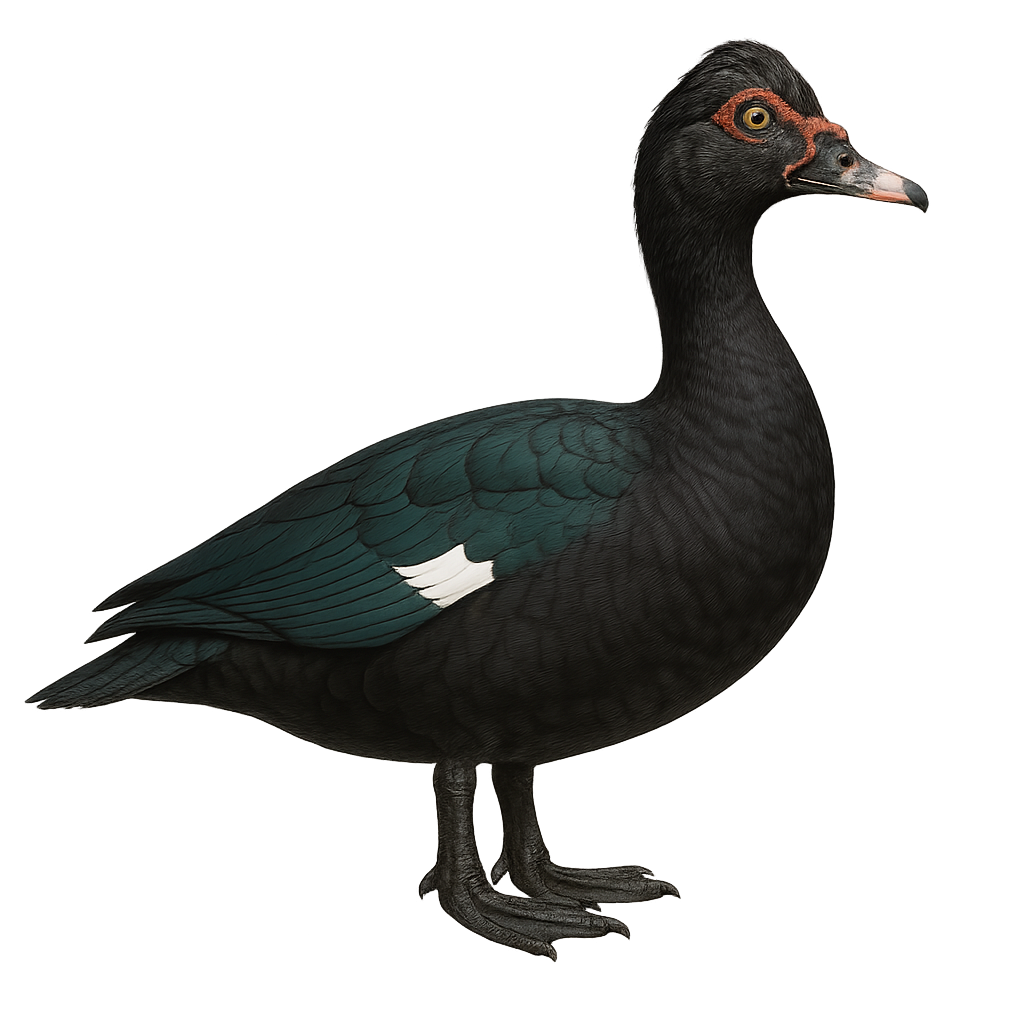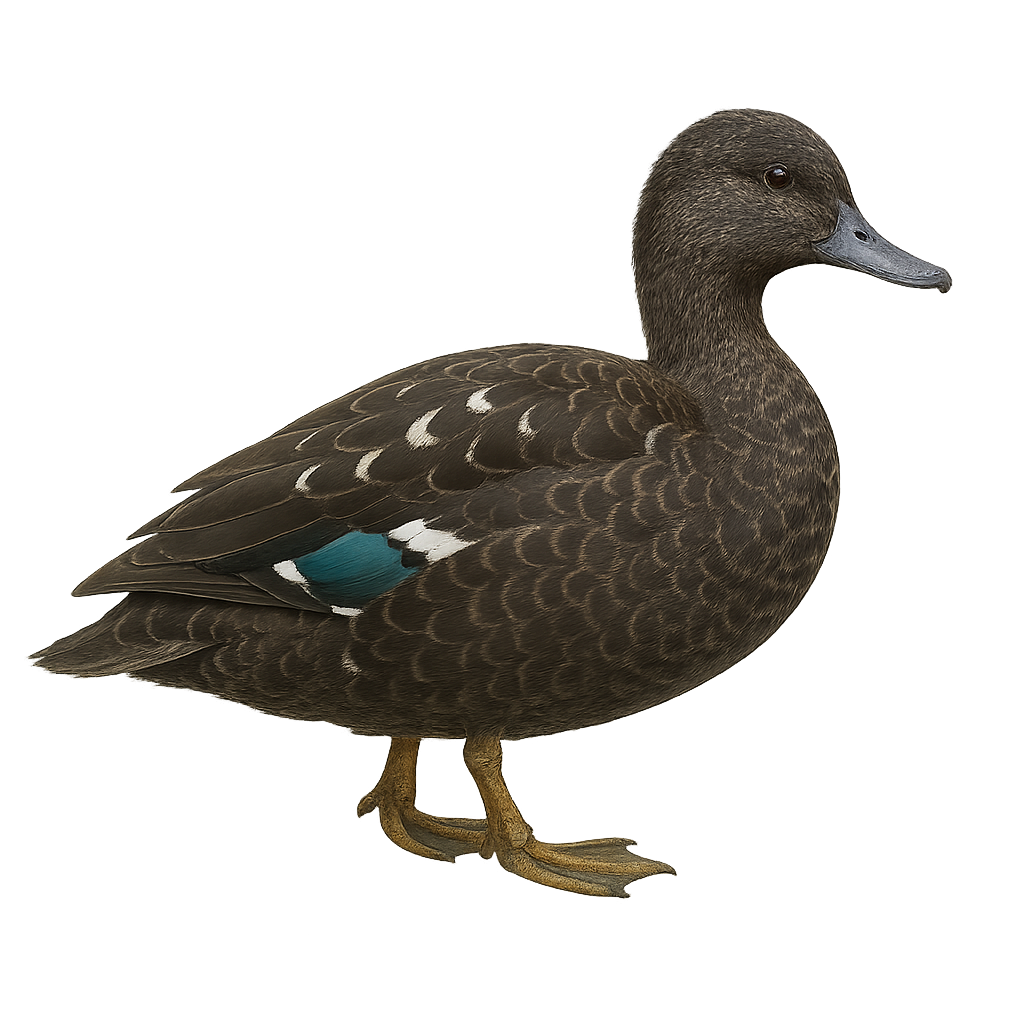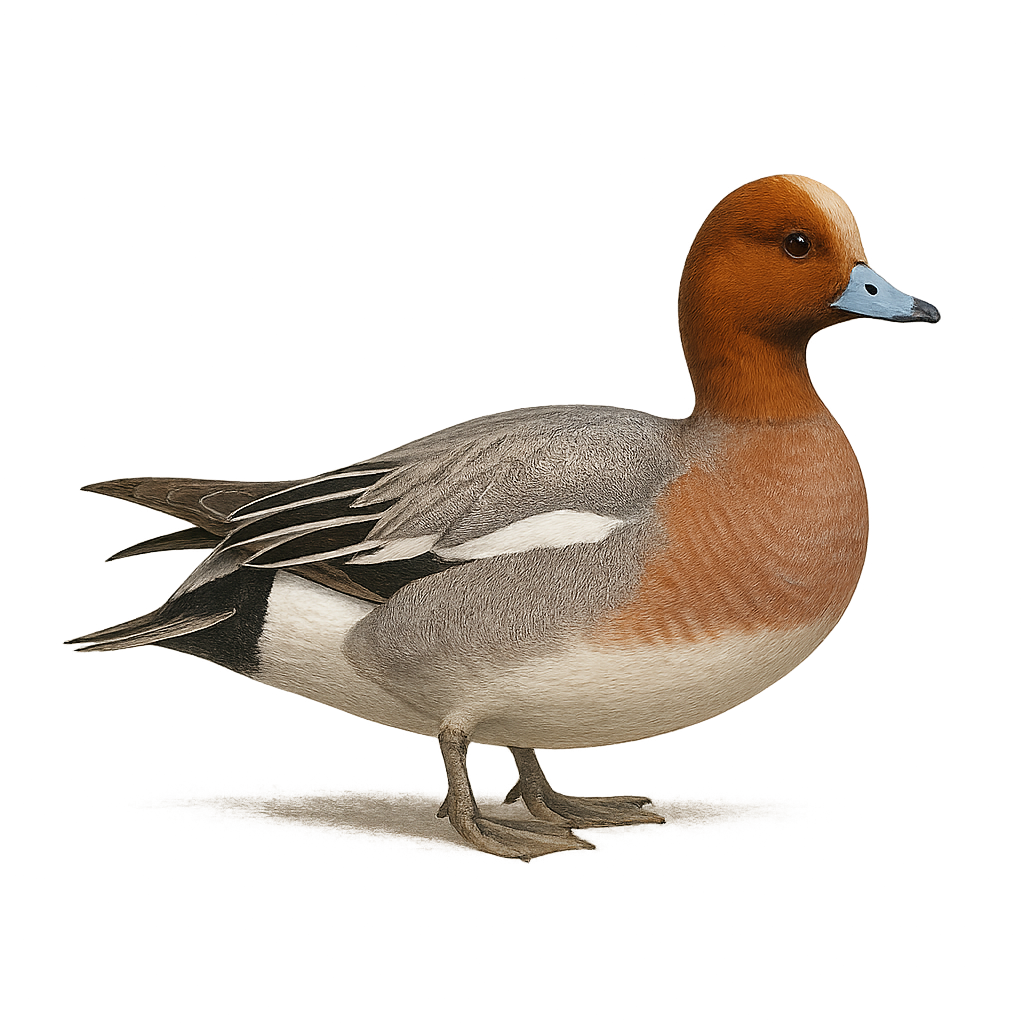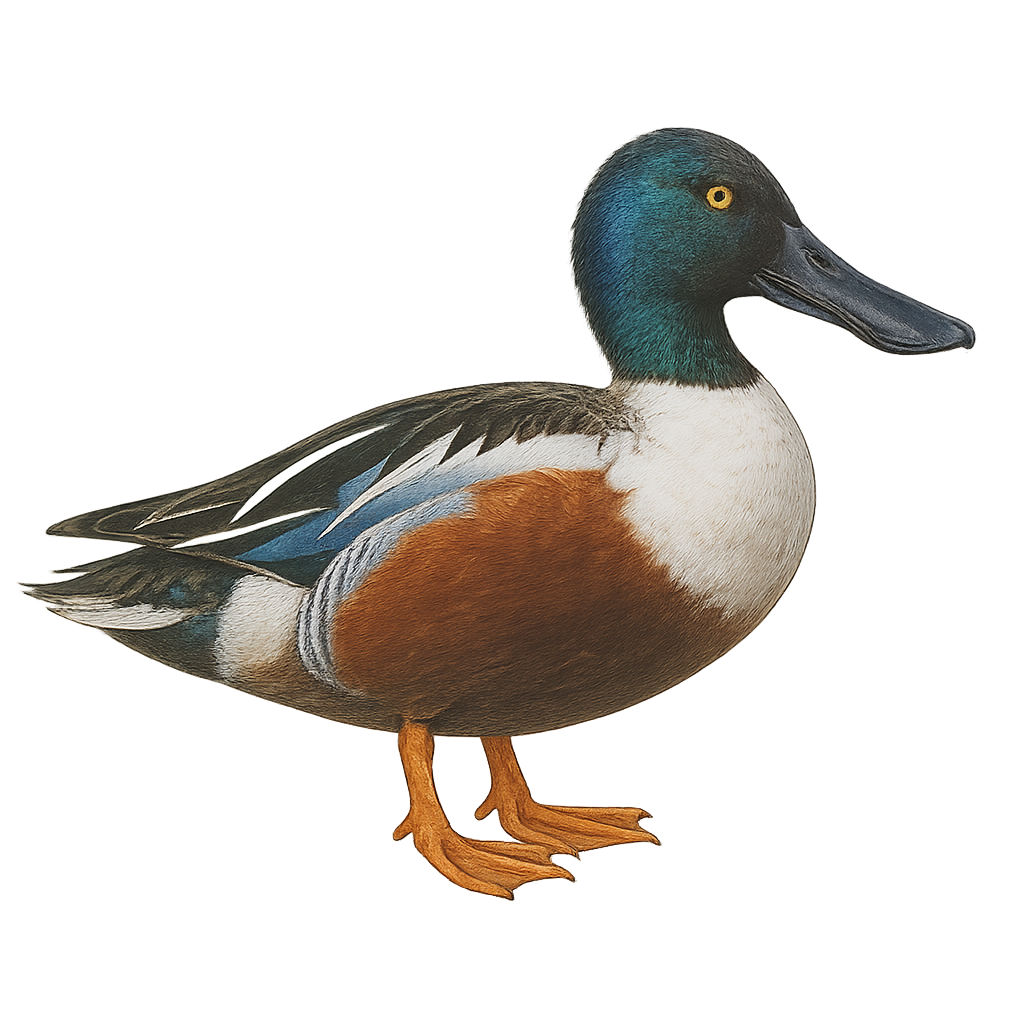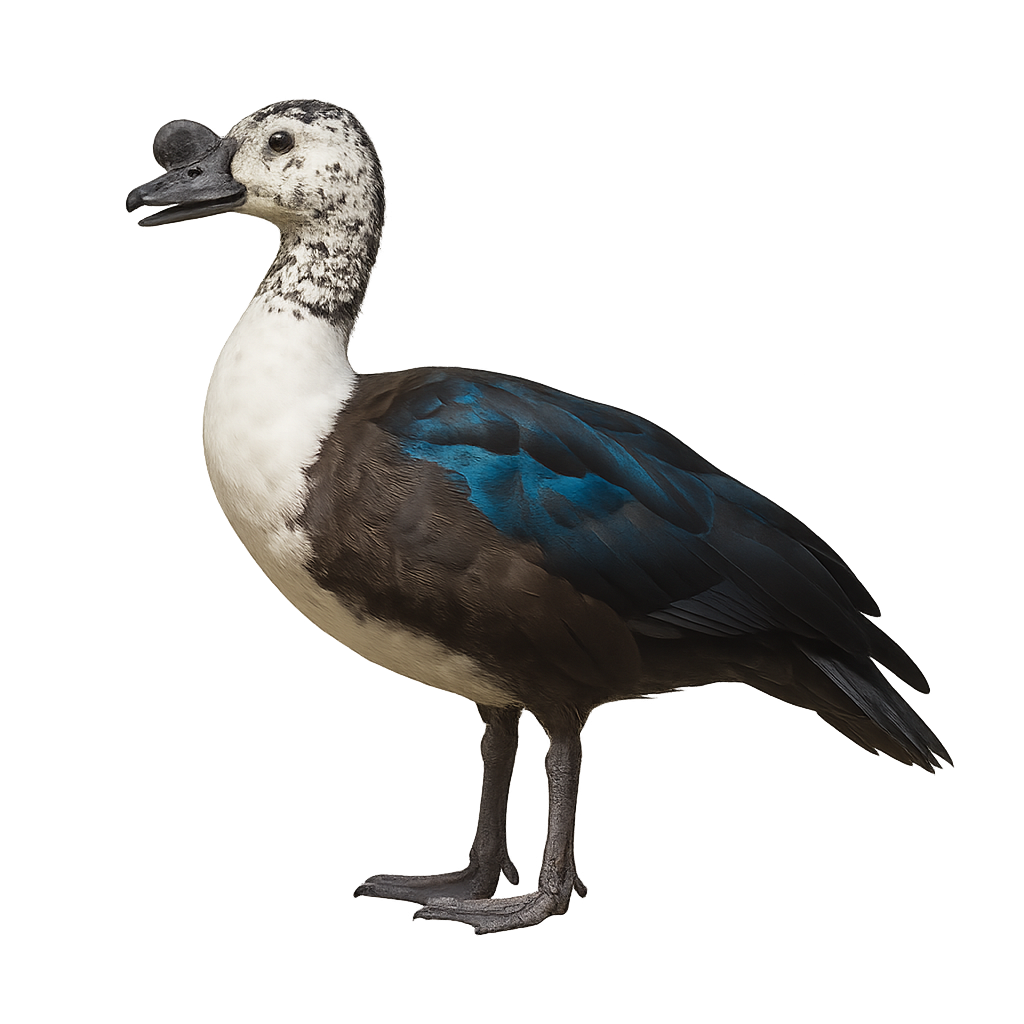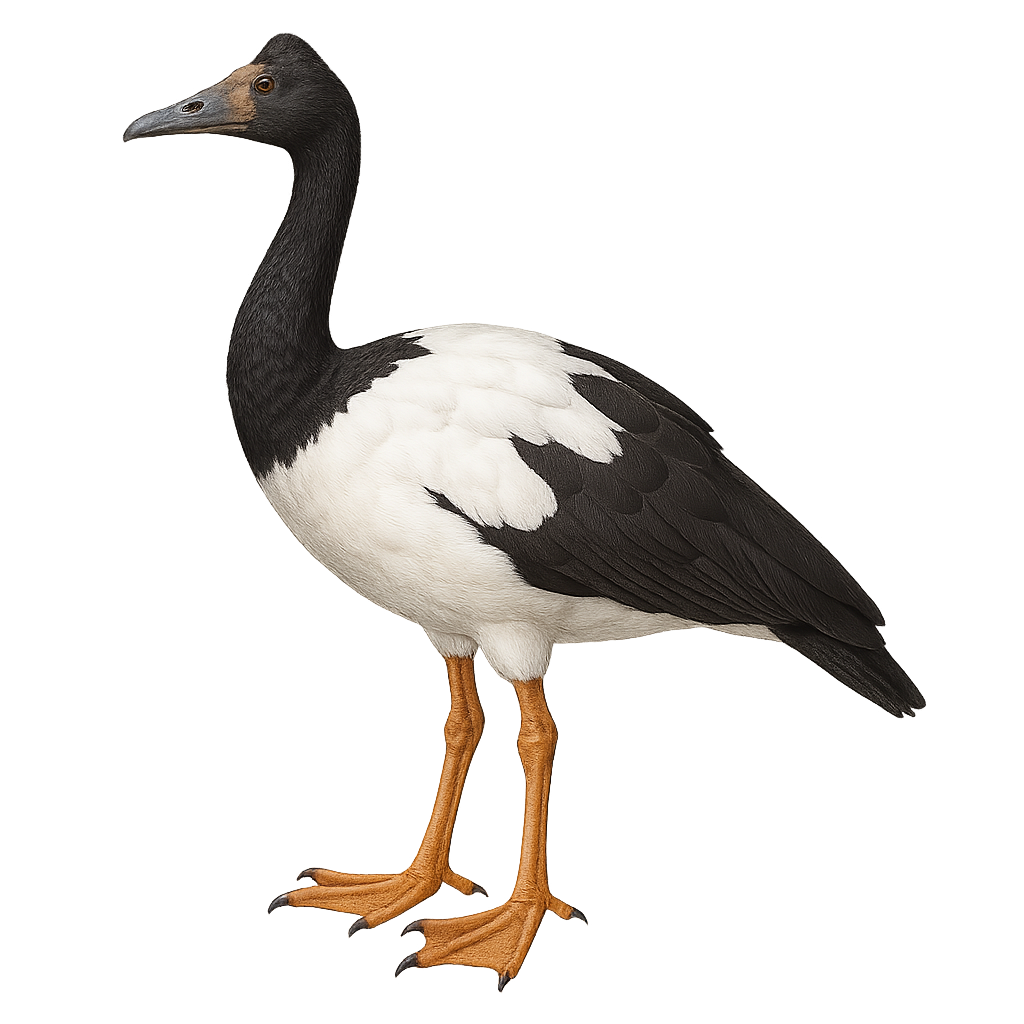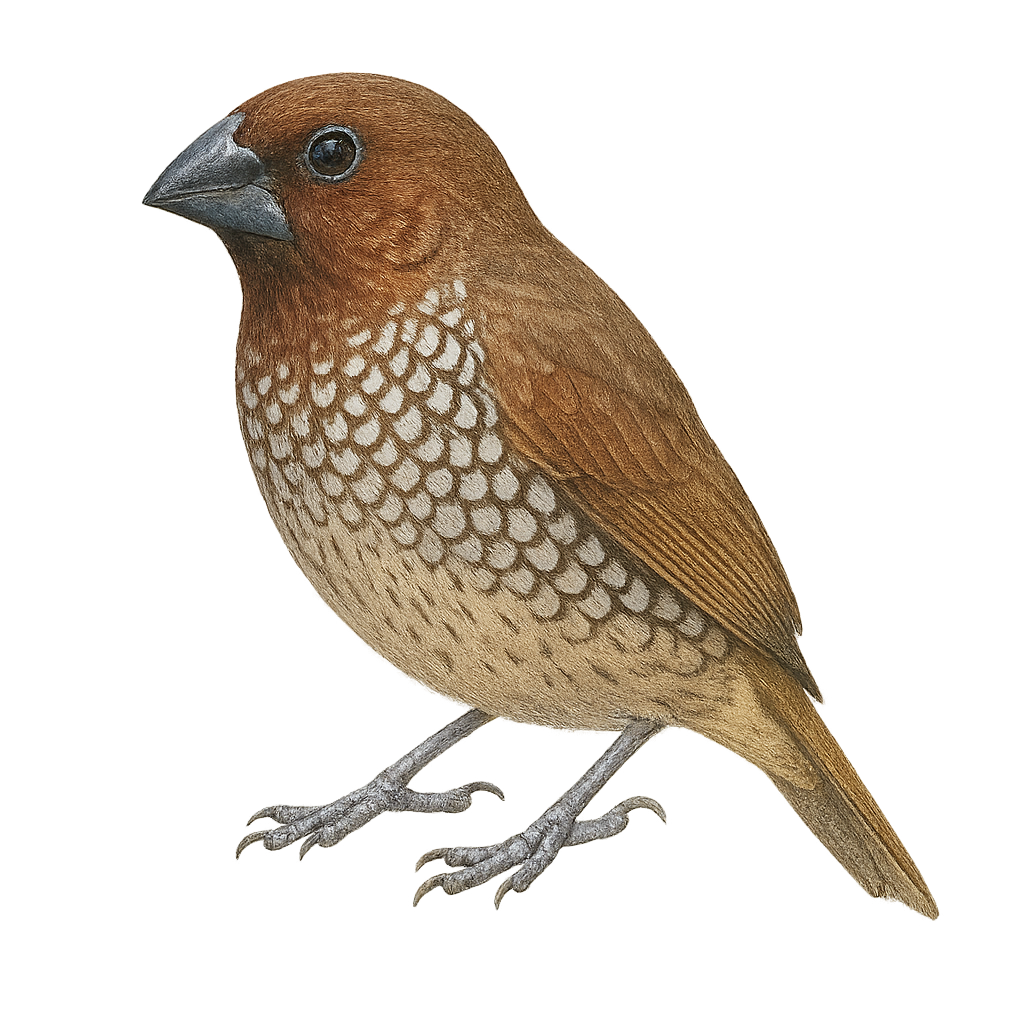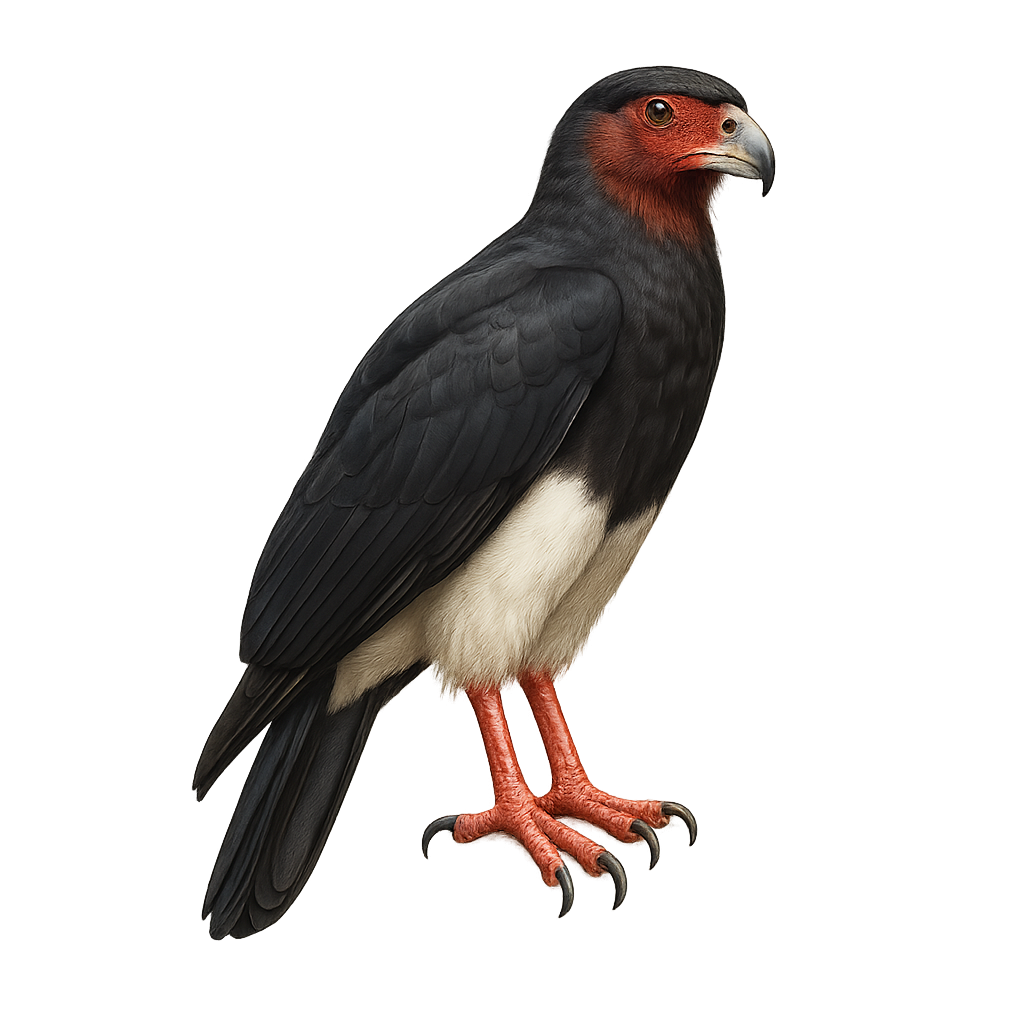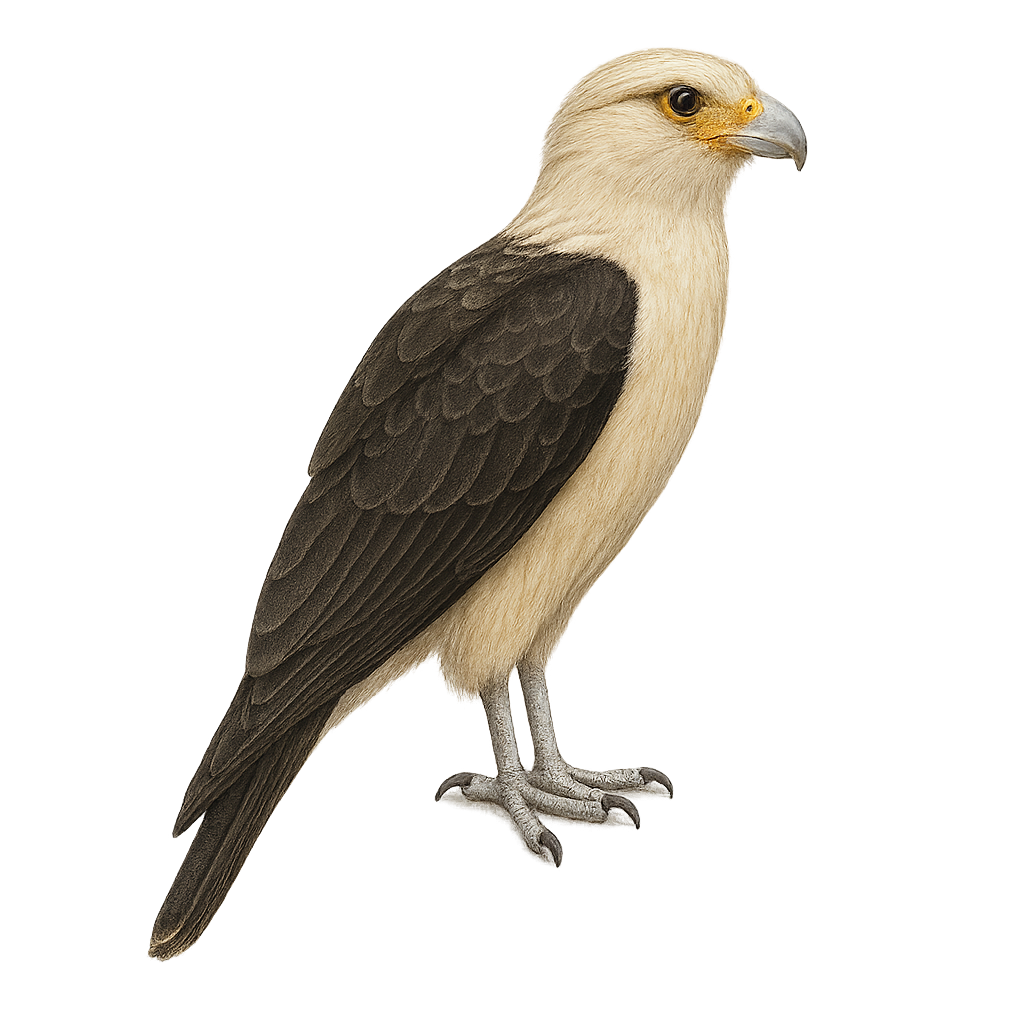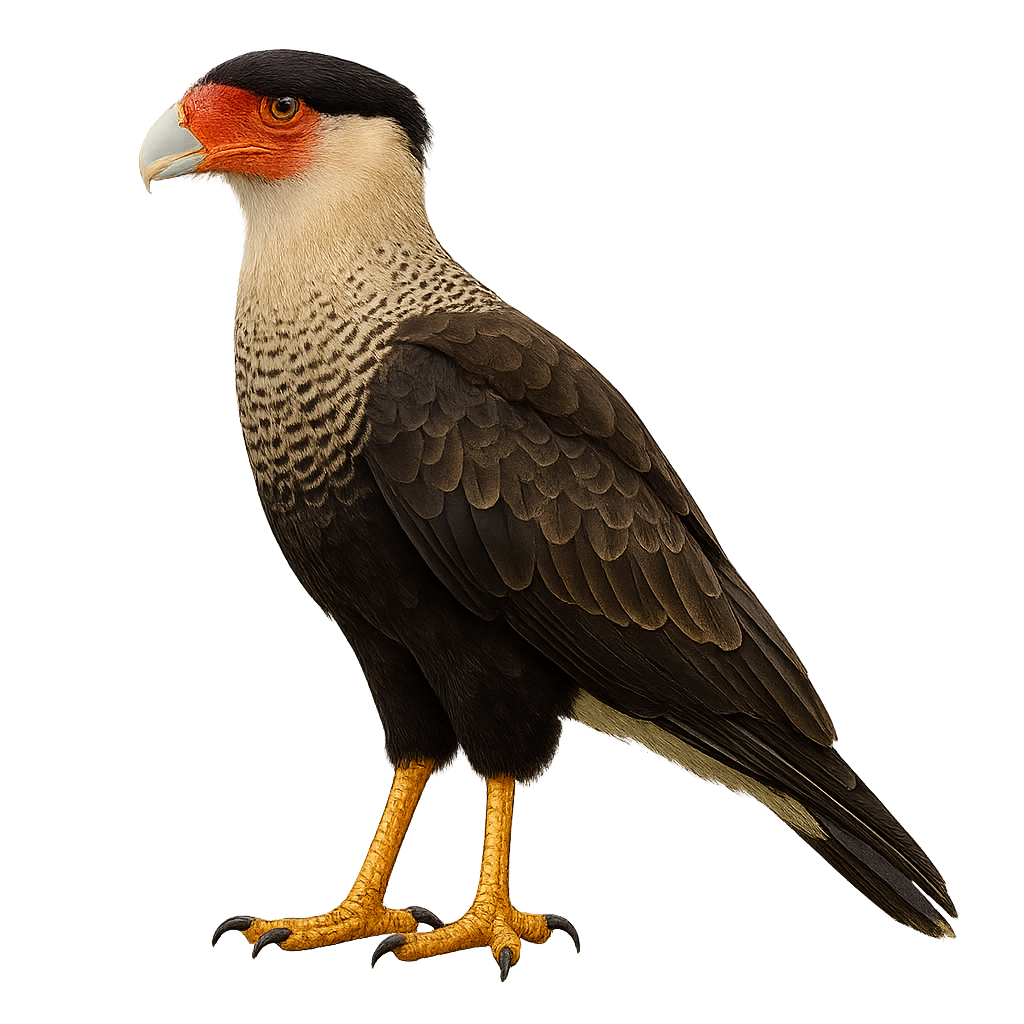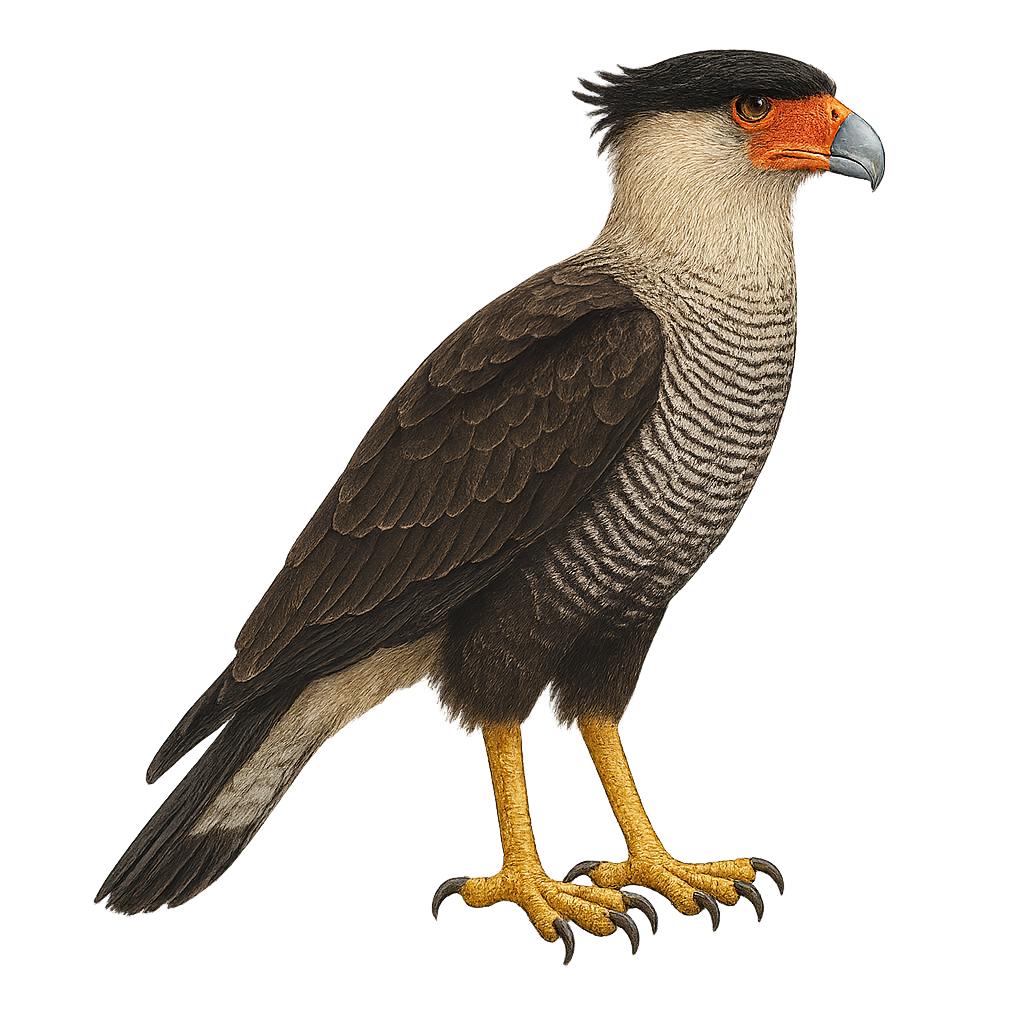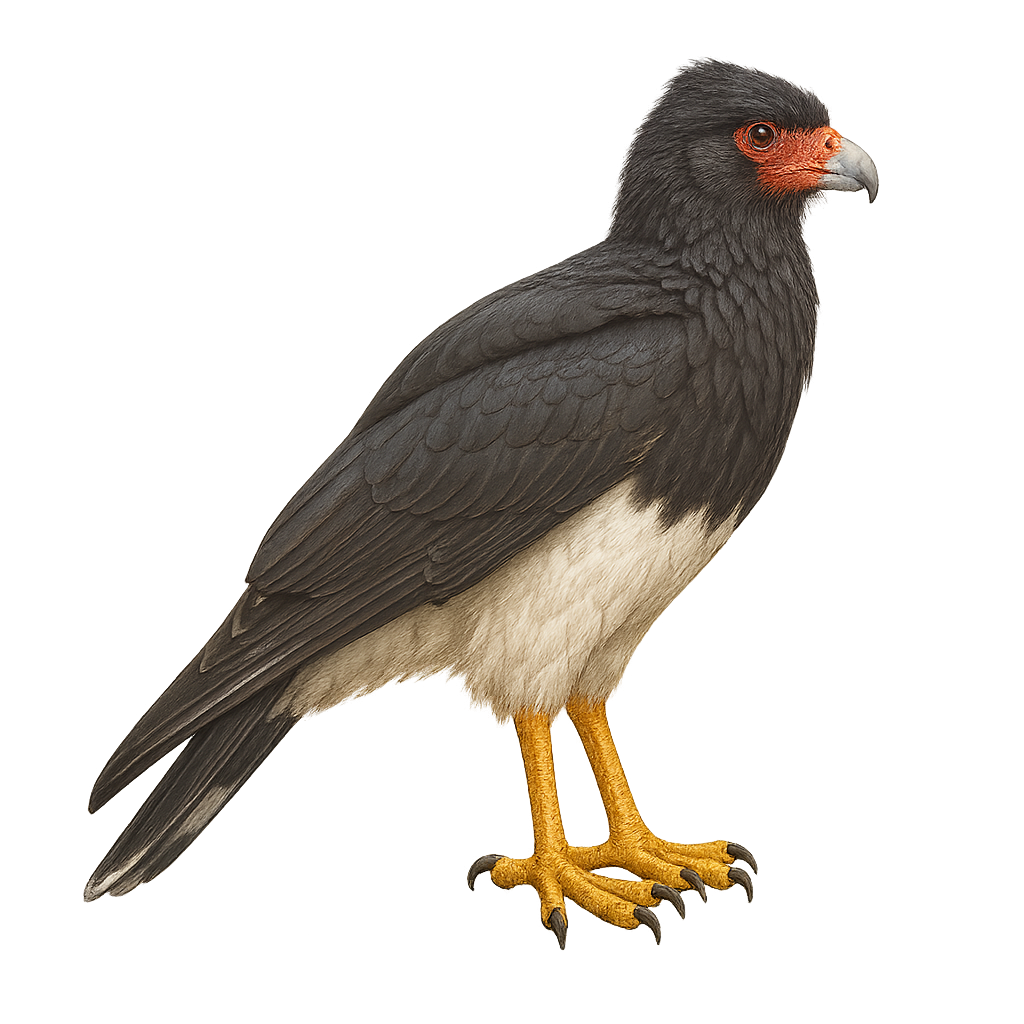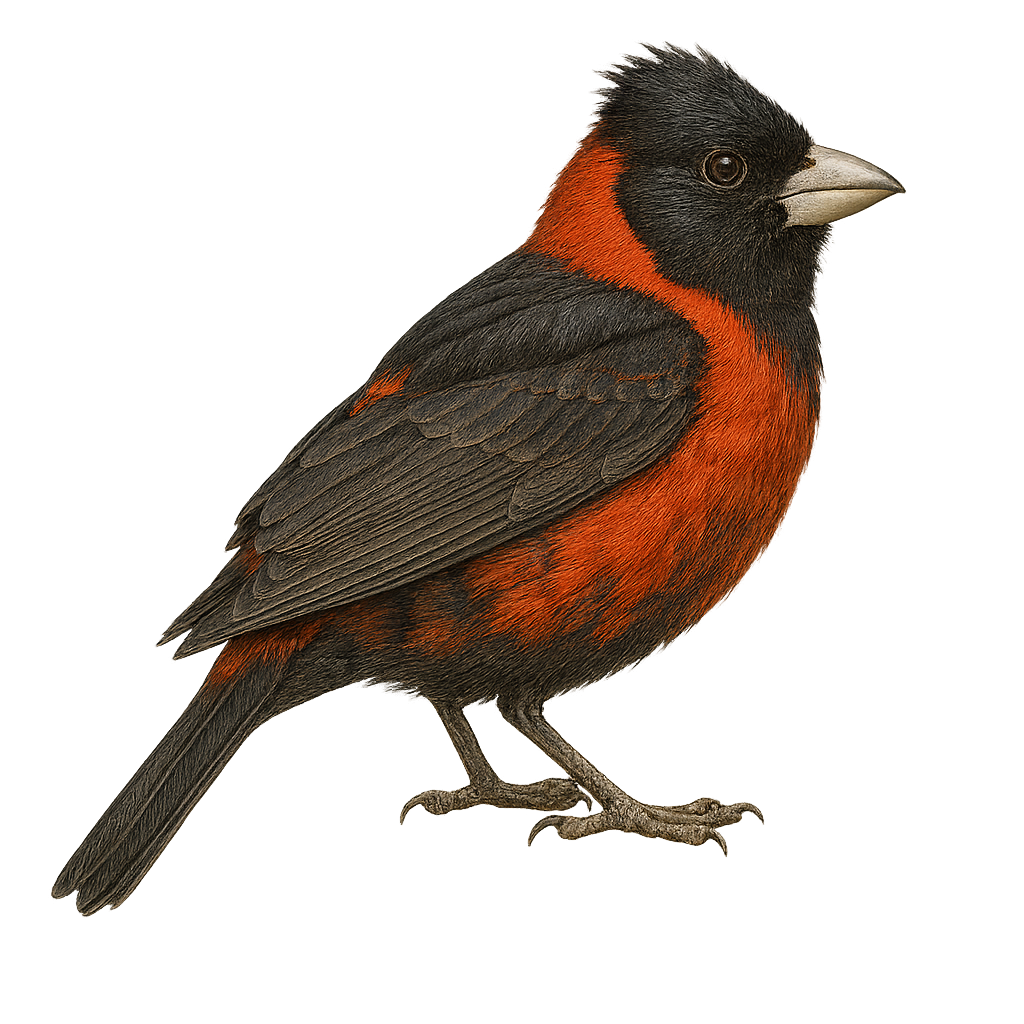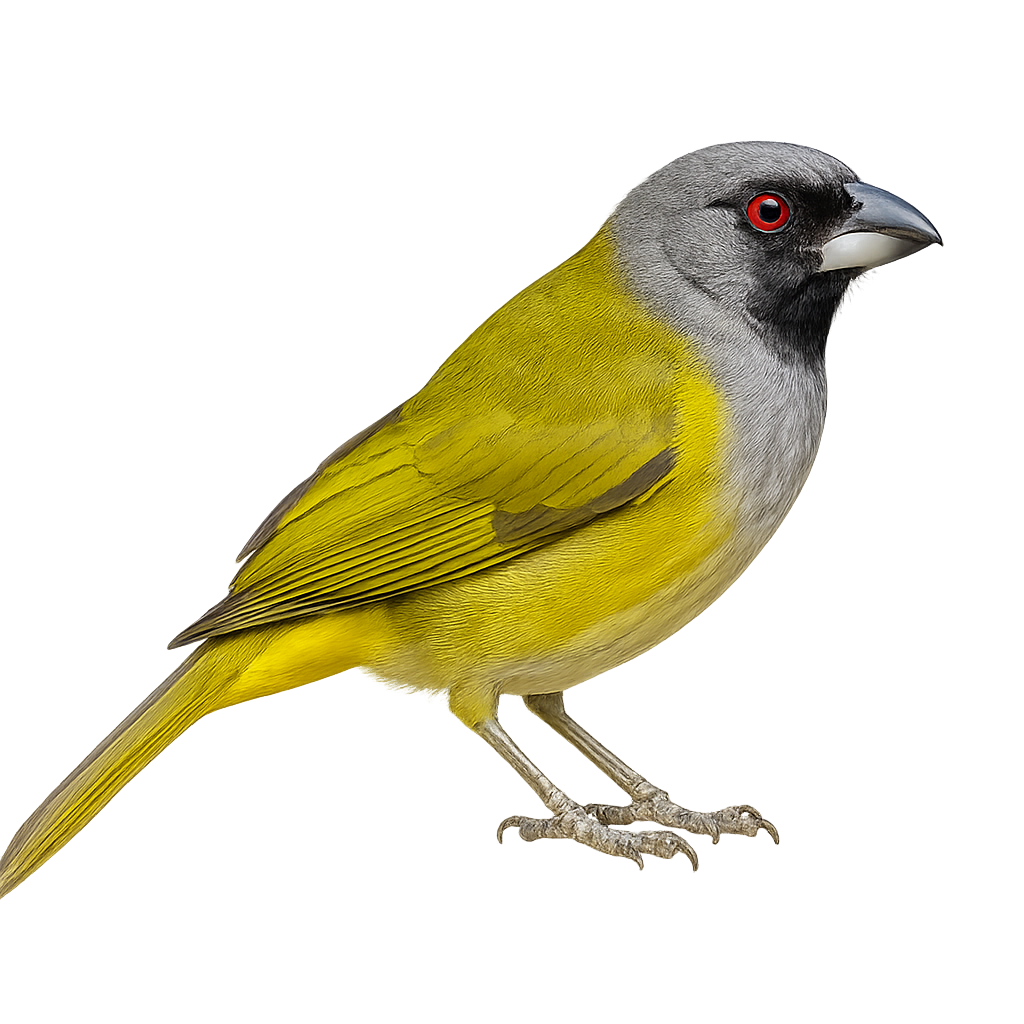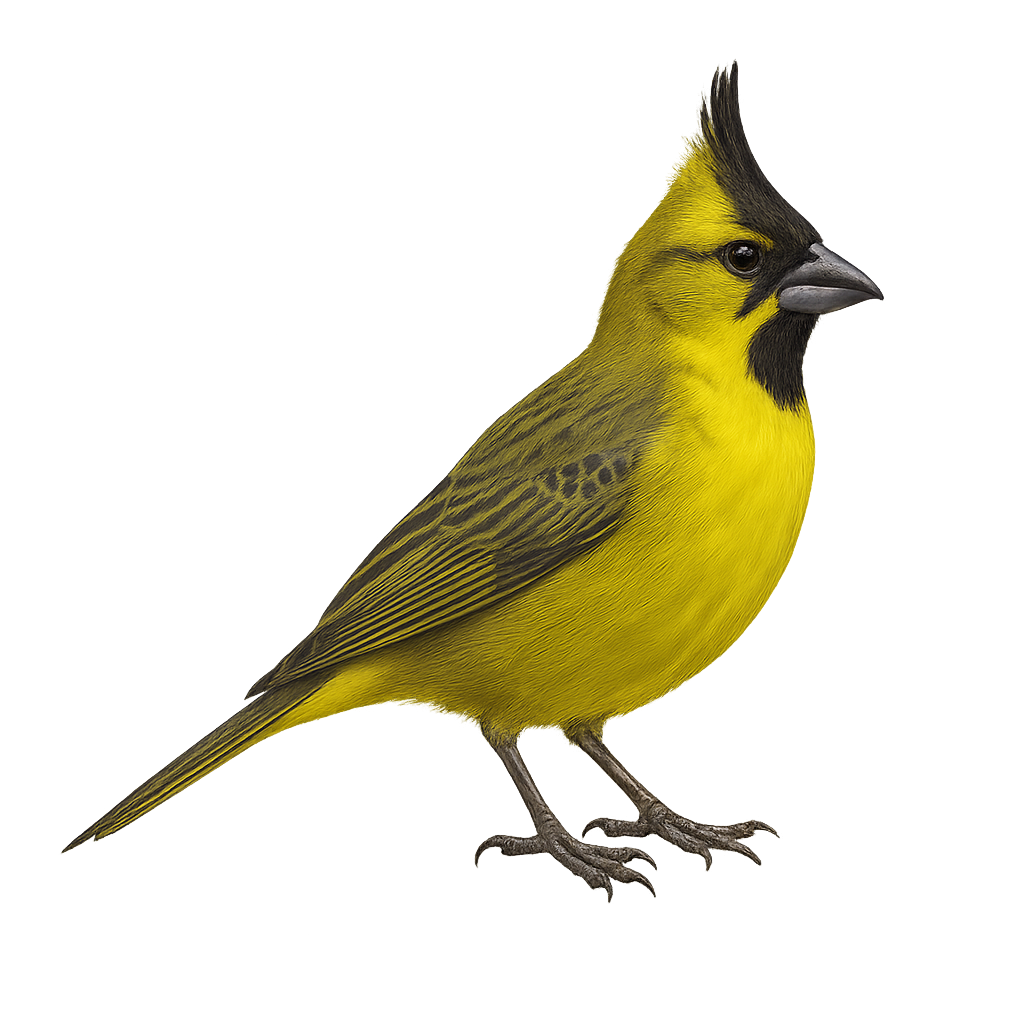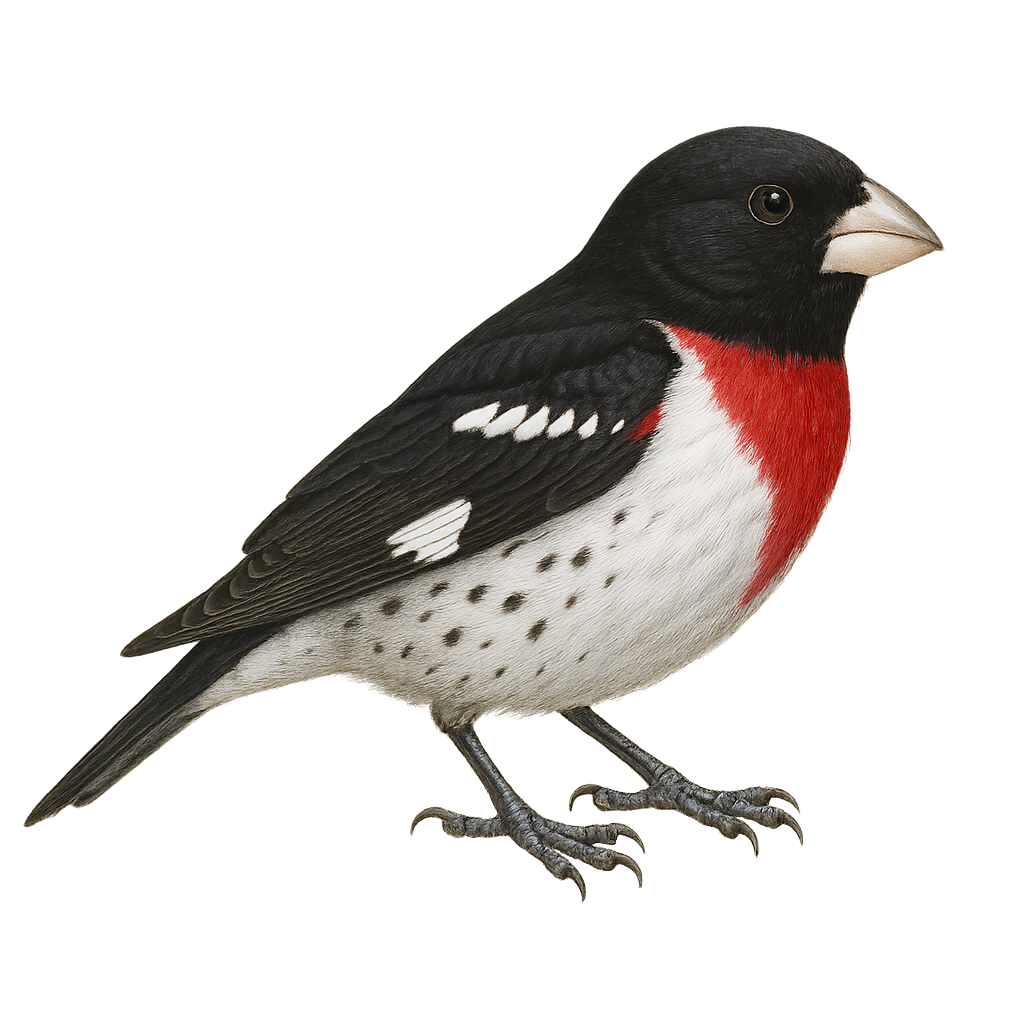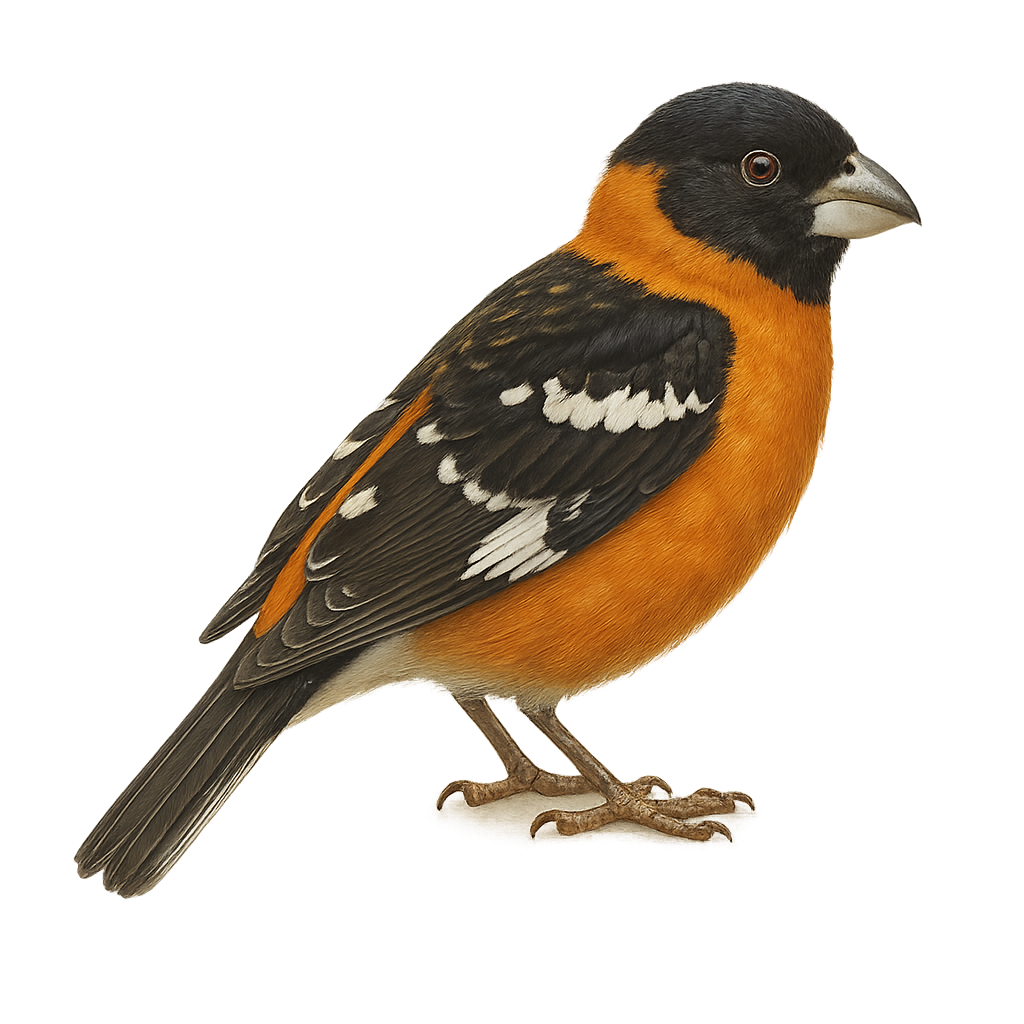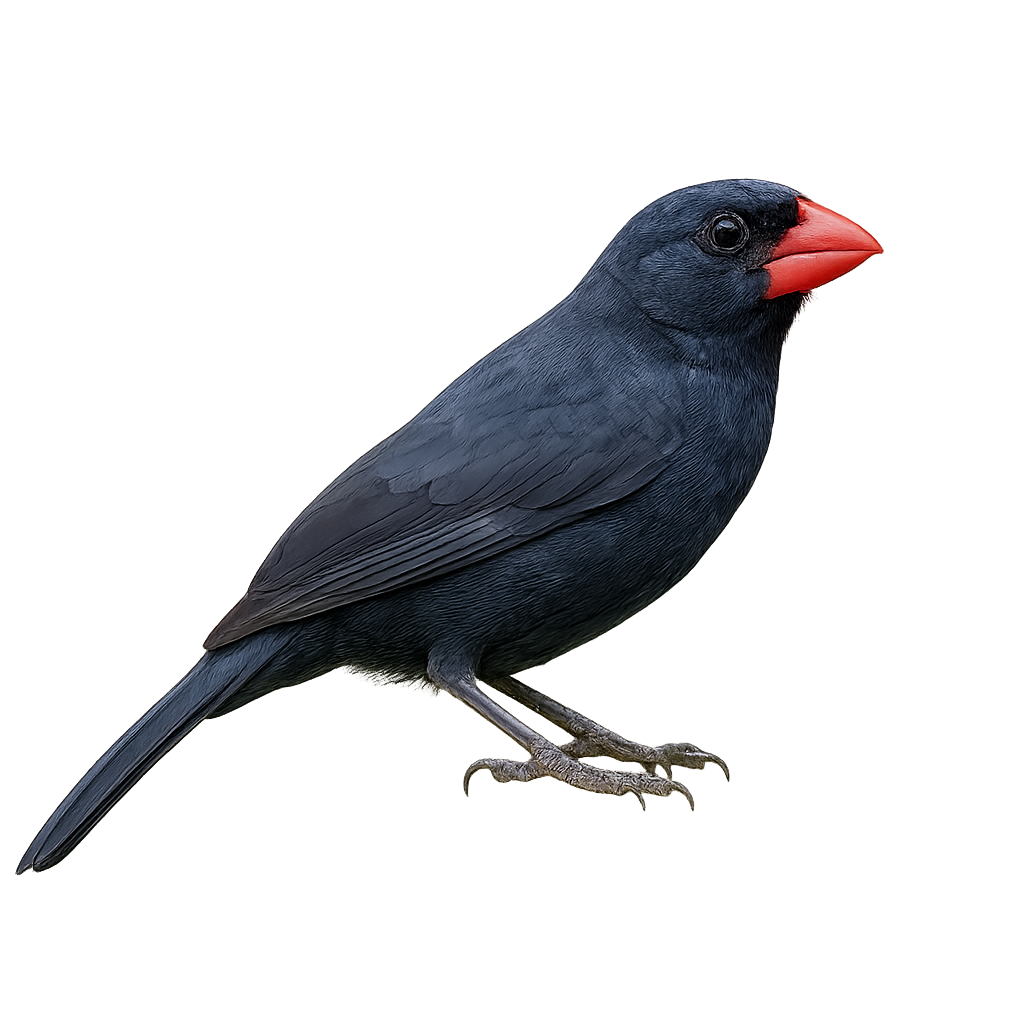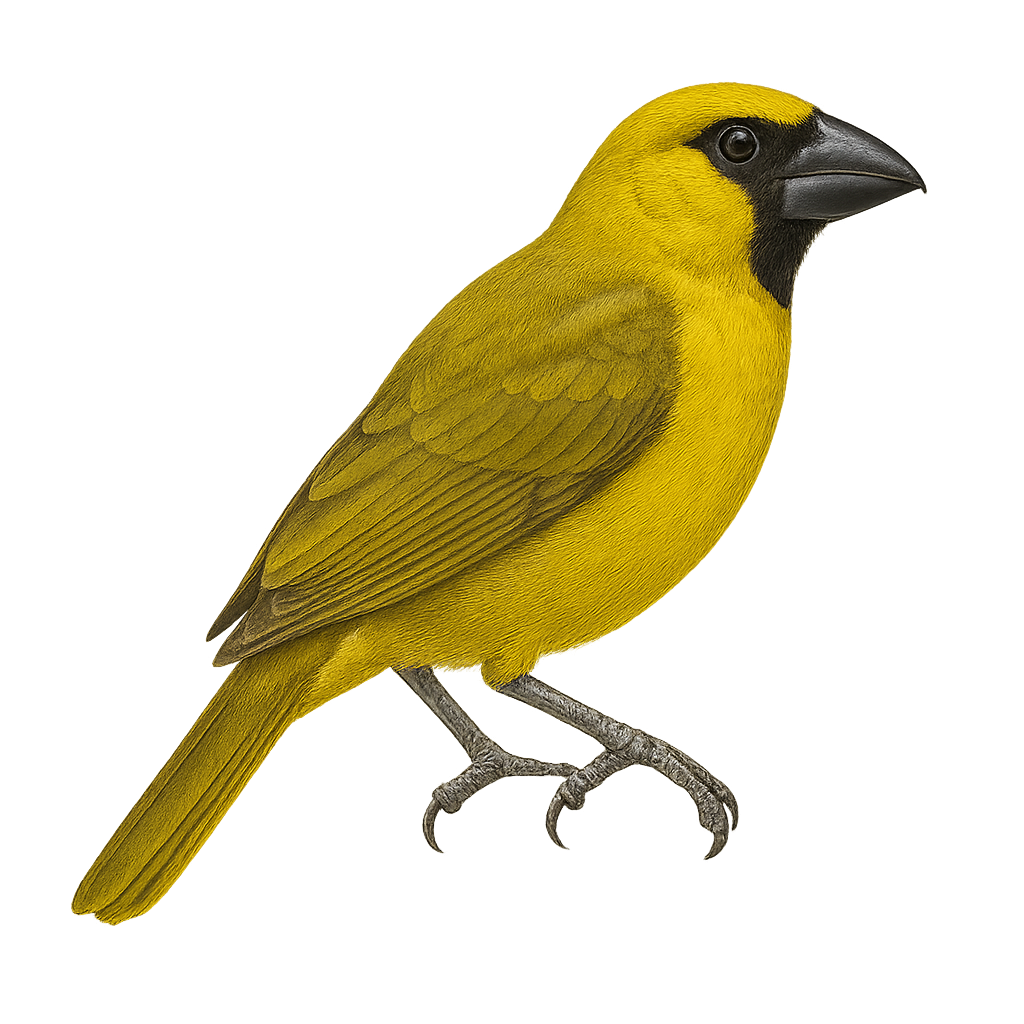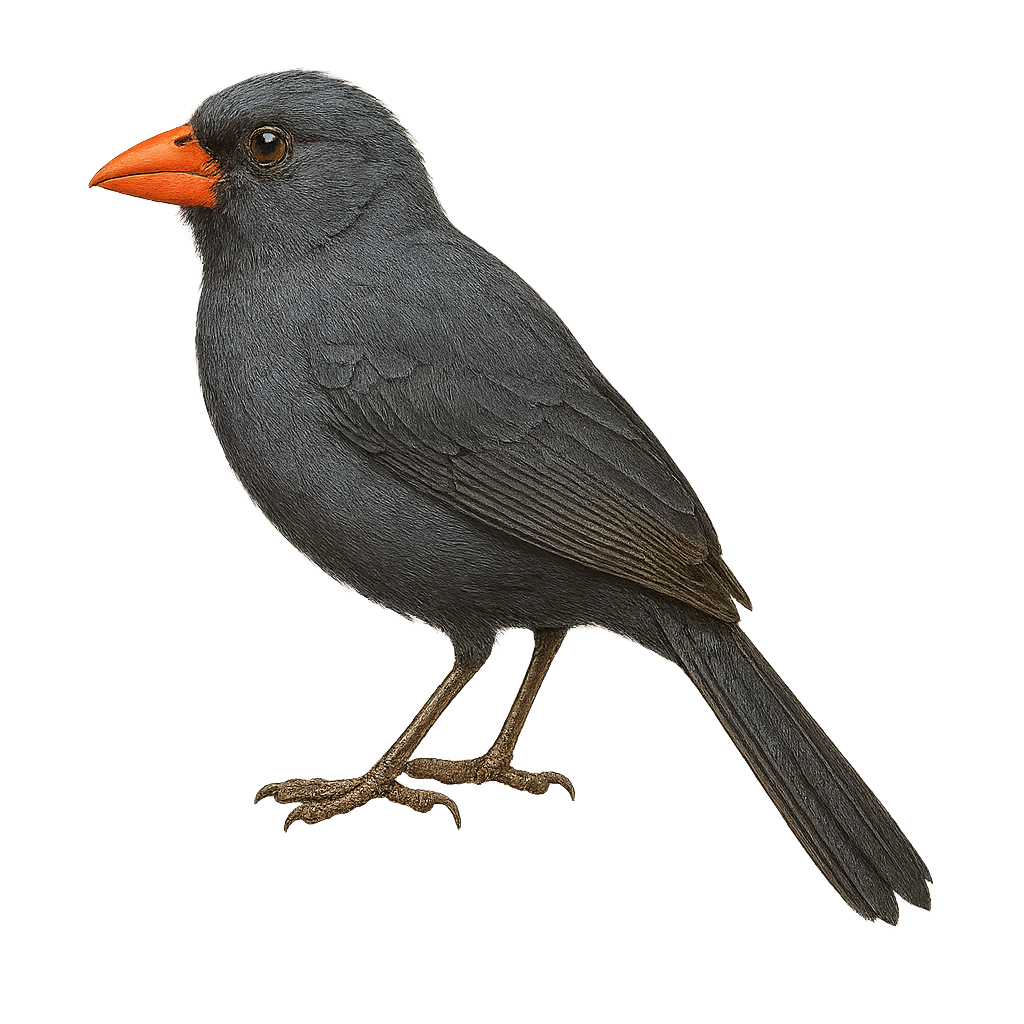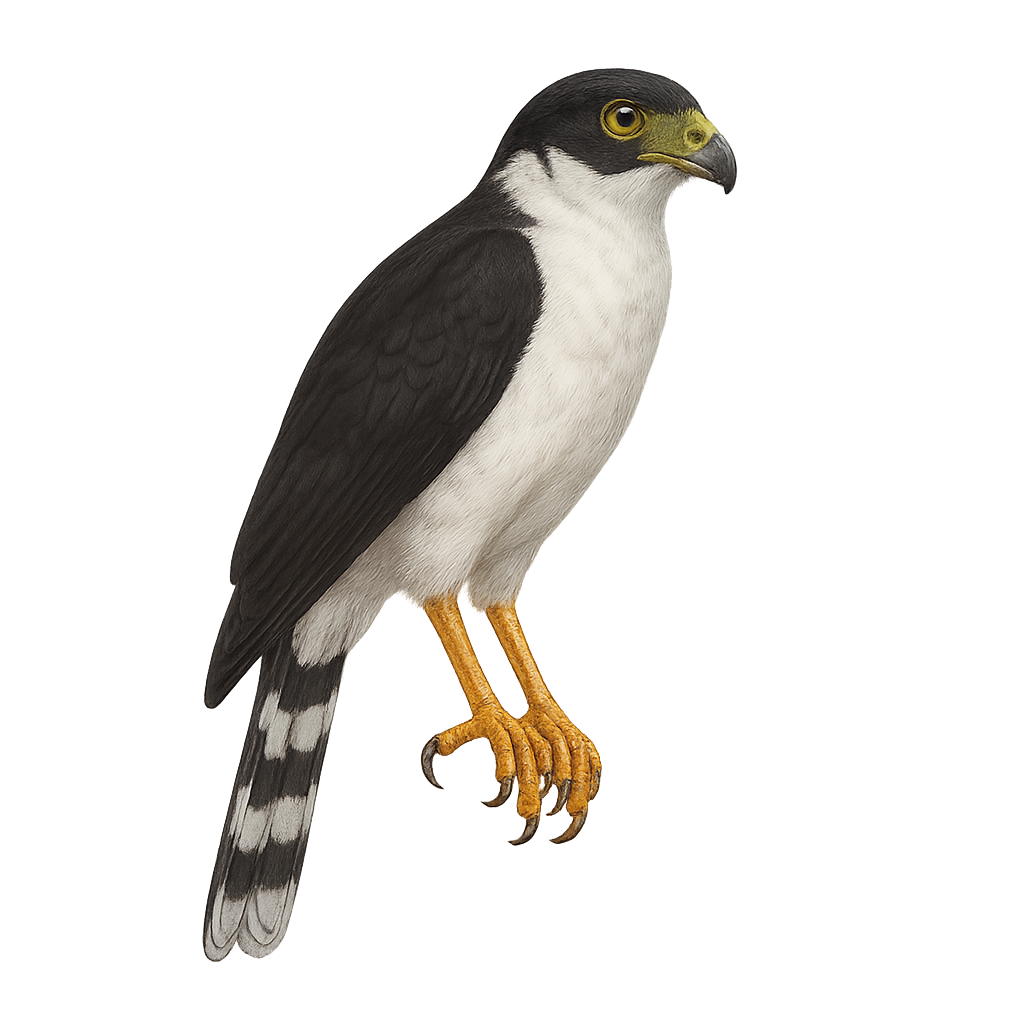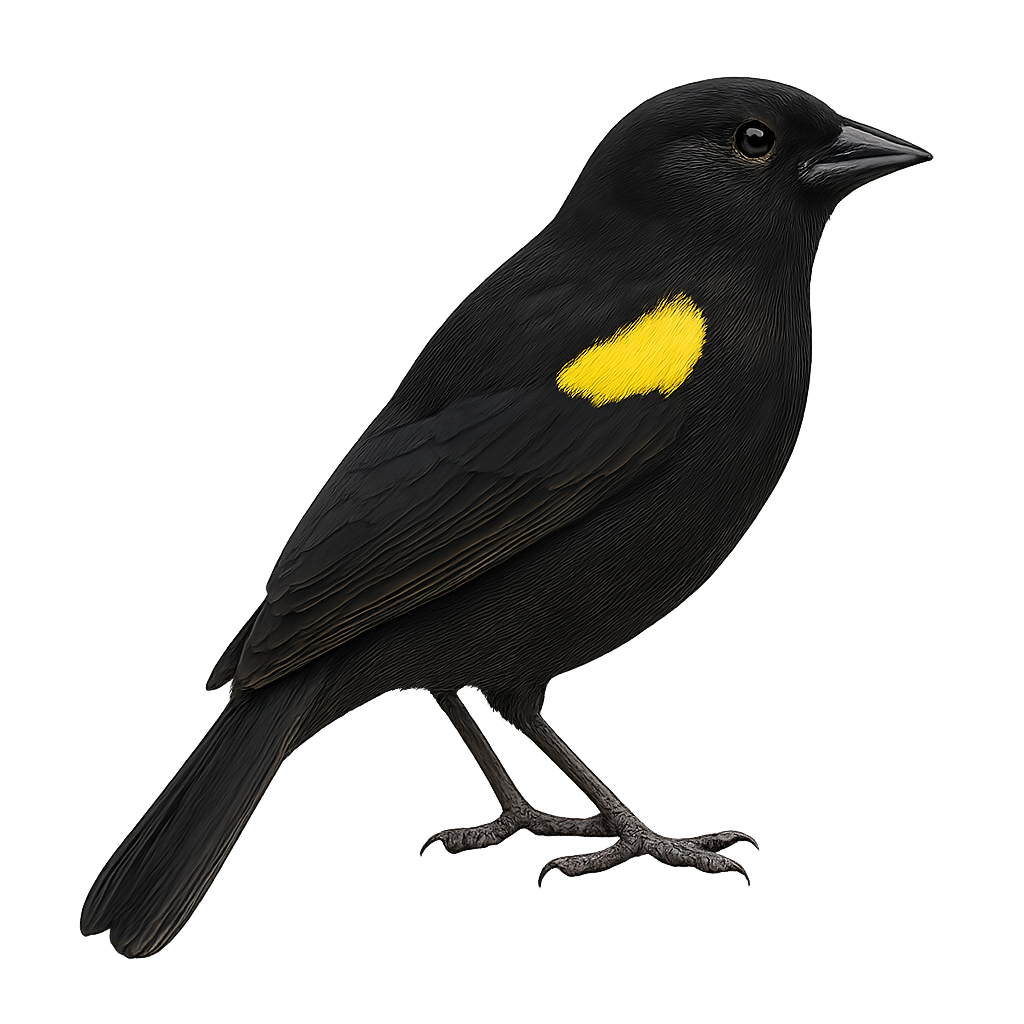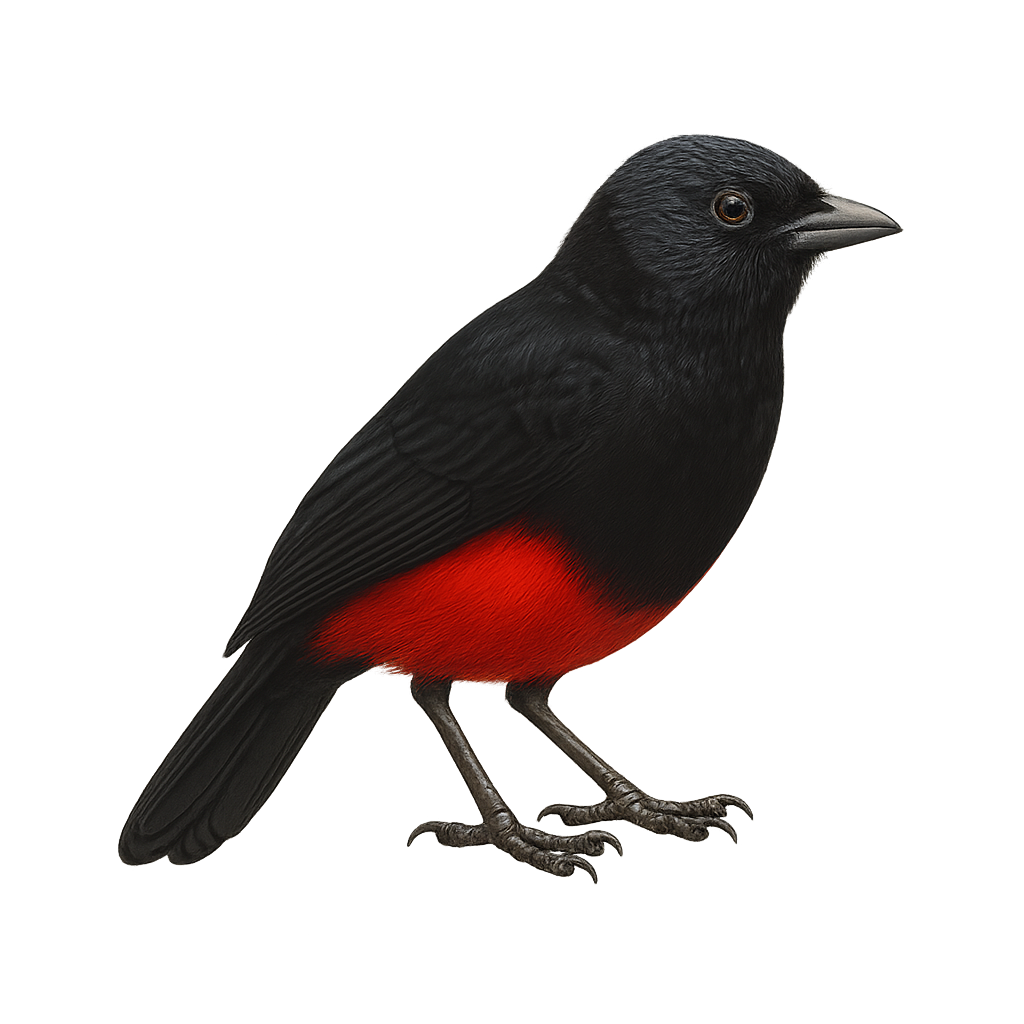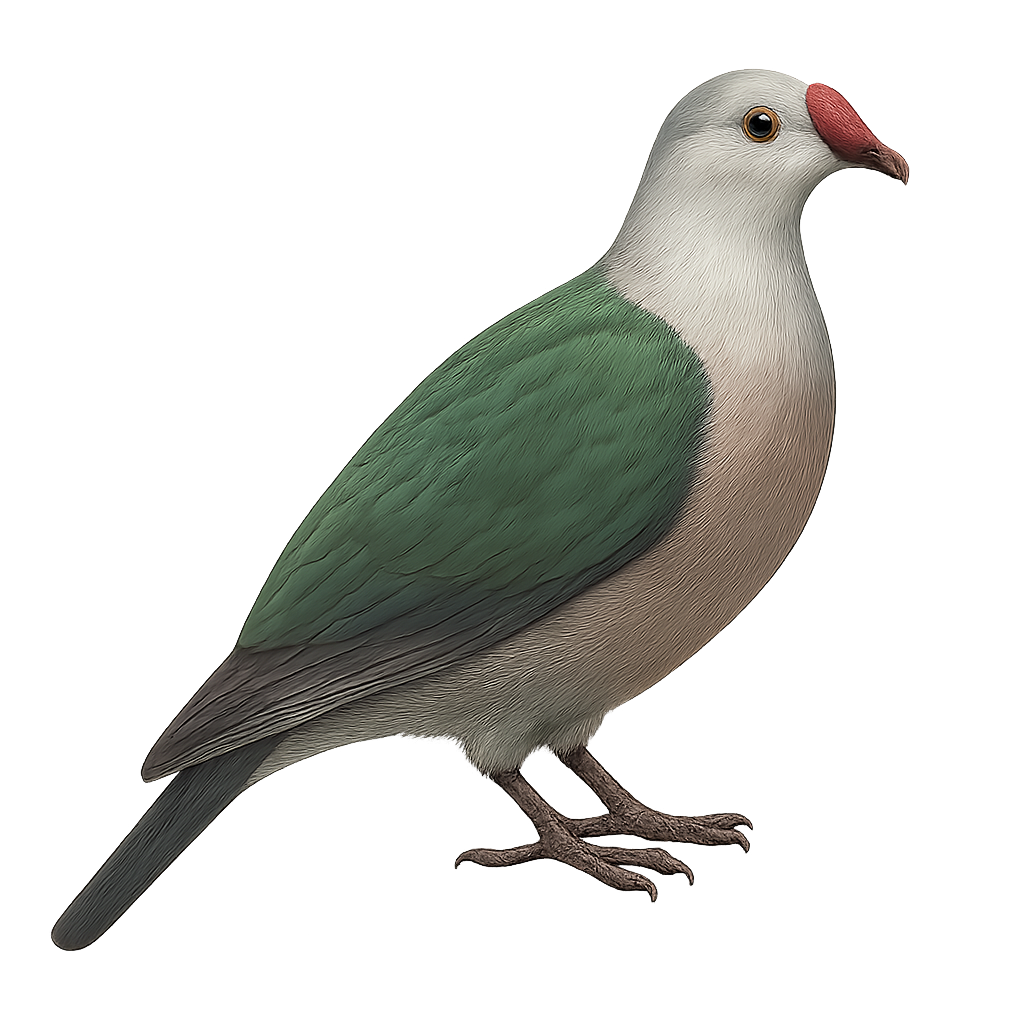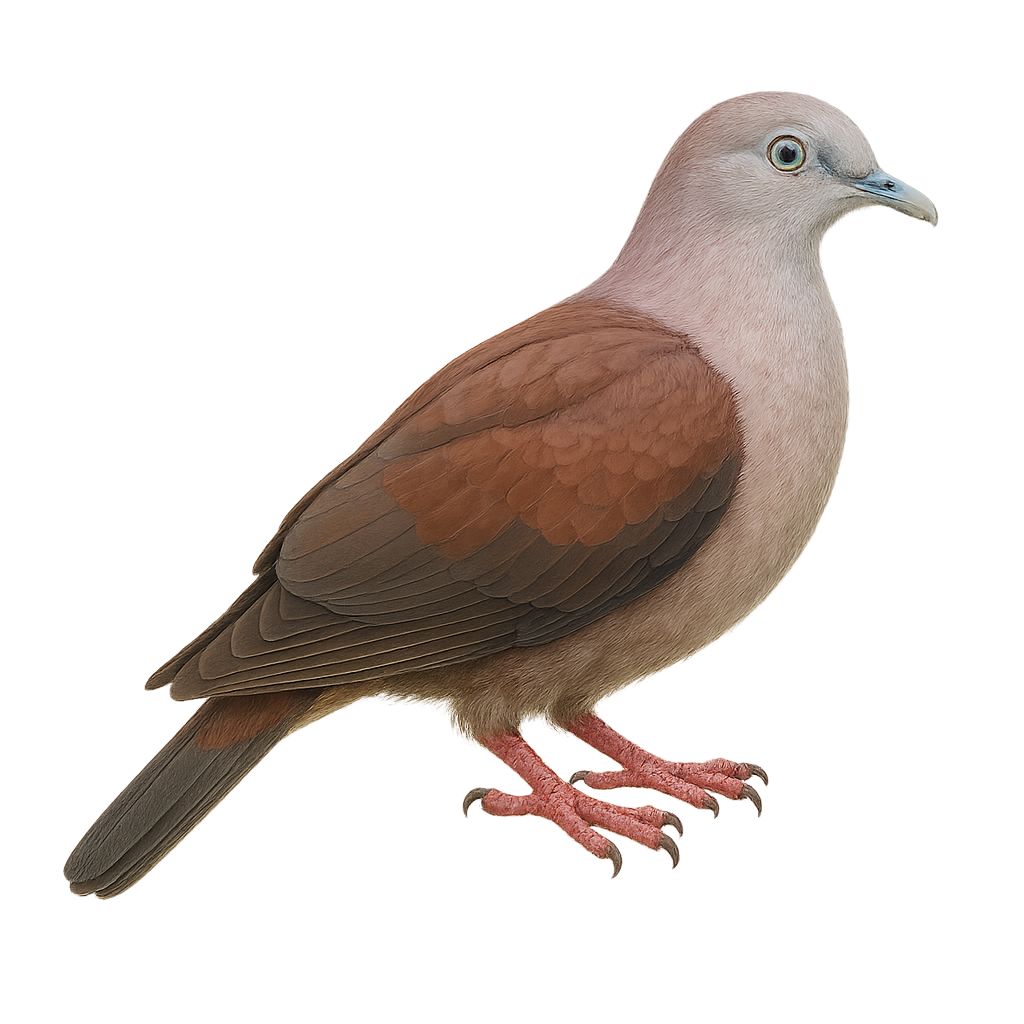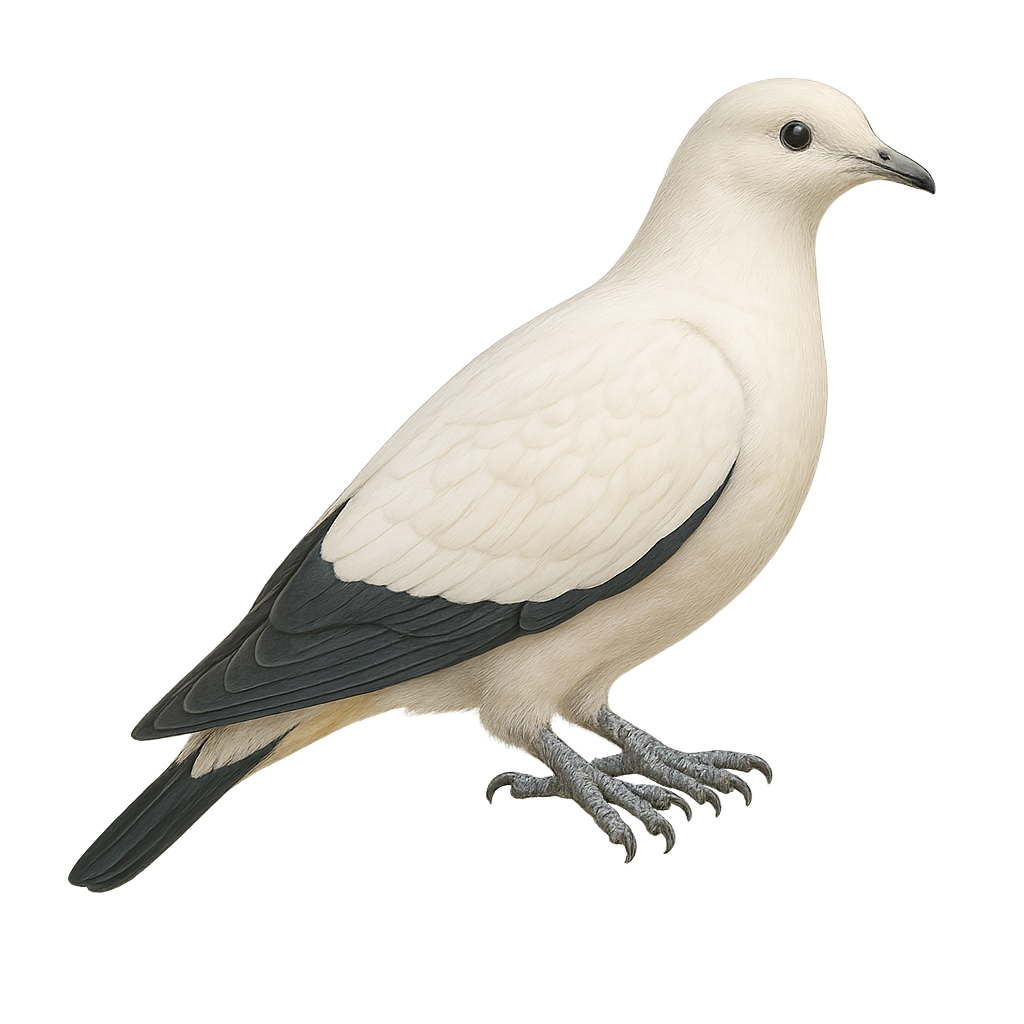The Muscovy Duck, Cairina moschata, is a large duck native to Central and South America. It is easily identified by its large size, distinctive black and white plumage, and the red caruncles around its beak. This duck prefers aquatic habitats such as marshes, slow-moving rivers, and lakes, where it feeds mainly on aquatic plants, insects, and small fish. Although often domesticated, the wild Muscovy Duck is more wary and tends to avoid humans. It is known for its strong and direct flight despite its size. Males are generally larger than females and can be quite territorial during the breeding season.
The African Black Duck, or Anas sparsa, is a medium-sized waterfowl known for its dark plumage and distinctive white wing markings. This duck is often found in fast-flowing rivers and streams in the mountainous regions of sub-Saharan Africa. Well adapted to its environment, it prefers swift waters where it can dive for small invertebrates and aquatic plants. Its discreet behavior and dark coloration allow it to blend into the shadows of waterways, making it difficult to spot. Although generally solitary or in small groups, it can sometimes be seen in pairs, especially during the breeding season.
The Northern Pintail is a migratory species of duck, easily recognizable by its slender body and long neck, which gives it an elegant and distinctive silhouette. The male during the breeding season has a colorful plumage, with a green head, brown body, and long bill. The female, on the other hand, has more subdued plumage, brown speckled, adapted for camouflage.
This duck primarily inhabits wetland areas, such as marshes, ponds, and rivers, where it feeds on aquatic vegetation, seeds, and insects. The Northern Pintail is a long-distance migrant, leaving its breeding grounds in Europe and Asia to head to Africa or the Middle East during the winter. Although still fairly widespread, the species is threatened by the loss of its natural habitat due to wetland drainage and intensified agriculture.
The Eurasian Wigeon is an elegant waterfowl, easily recognizable by its distinctive plumage and characteristic whistle. The male, during the breeding season, has colorful plumage with a dark green head, light brown body, and a white stripe running across its neck. The female is more subdued, with speckled brown plumage, adapted for camouflage. This duck gets its name from the whistling sound it makes during its movements and social interactions.
The Eurasian Wigeon primarily inhabits wetlands, such as lakes, ponds, and marshes, where it feeds on aquatic plants, seeds, and insects. It is a long-distance migratory bird, leaving its breeding grounds in Europe to travel to warmer regions in Africa or the Middle East during the winter. While its population remains generally stable, it faces threats related to habitat loss and water pollution.
The Northern Shoveler is a medium-sized dabbling duck, measuring between 44 and 56 cm in length with a wingspan of 70 to 85 cm. The breeding male features an iridescent dark green head, white chest, chestnut flanks, and a large spatula-shaped bill. The female has mottled brown plumage and a similarly shaped bill. This species inhabits shallow wetlands, such as marshes, ponds, and floodplain meadows rich in aquatic vegetation. It feeds by filtering water with its specialized bill, consuming primarily plankton, aquatic insects, crustaceans, mollusks, and seeds. Migratory, the Northern Shoveler breeds in Europe and Asia, wintering in Africa, India, and Southeast Asia. Although listed as Least Concern by the IUCN, it is sensitive to wetland degradation.
The Sarkidiornis sylvicola, commonly known as the Comb Duck, is a distinctive waterfowl known for its unique appearance. This large duck features predominantly white plumage with iridescent sheens on its wings and back. Males are notable for a prominent knob on their bill, which becomes more pronounced during the breeding season. Females are smaller and have duller plumage. This duck primarily inhabits wetlands, lakes, and rivers in the tropical and subtropical regions of South America. It is often seen in small groups, feeding on aquatic plants, seeds, and insects. Although currently listed as "Least Concern," habitat degradation could pose a future threat.
The Magpie Goose, Anseranas semipalmata, is a distinctive waterbird belonging to the family Anseranatidae. It is characterized by its striking black and white plumage, long legs, and partially webbed feet, which give it its name. This bird is primarily found in the wetlands of northern Australia and New Guinea. Unlike most other waterbirds, the Magpie Goose can perch in trees thanks to its sharp claws. It lives in groups and primarily feeds on aquatic plants. Its breeding season coincides with the rainy season when food resources are plentiful.
The Scaly-breasted Munia, or Lonchura punctulata, is a small granivorous bird native to South and Southeast Asia. It is easily recognizable by its brown plumage with scaly patterns on the chest and belly. Measuring about 11 to 12 cm in length, this bird is often seen in flocks in fields, gardens, and grassy areas. It adapts well to human-modified environments, allowing it to thrive in both urban and rural areas. The Scaly-breasted Munia is a sociable bird, often seen feeding in groups. It primarily feeds on seeds but can also consume small insects. Its ability to adapt to various habitats and its gregarious behavior make it a fascinating bird to observe.
The Red-throated Caracara, Ibycter americanus, is a fascinating bird of prey belonging to the Falconidae family. It is distinguished by its bright red throat and black and white plumage. This bird is primarily found in the tropical forests of Central and South America, where it plays an important ecological role as a predator of insects and small vertebrates. The Red-throated Caracara is known for its social behavior, often observed in noisy family groups. It is also recognized for its ability to dislodge wasp nests, feeding on the larvae. Although its conservation status is currently "least concern," deforestation poses a potential threat to its natural habitat.
The Yellow-headed Caracara, Milvago ferrugineus, is a medium-sized raptor known for its pale head and rusty-brown plumage. It primarily inhabits open regions of South America, from savannas to agricultural areas. An opportunistic feeder, it consumes carrion, insects, and occasionally small vertebrates. Its flight is often slow and gliding, and it is frequently seen walking on the ground in search of food. Although a bird of prey, it is less aggressive than other raptors. Its adaptability to various environments has allowed it to thrive despite environmental changes.
The Northern Caracara is an imposing bird of prey, easily recognizable by its distinctive black and white plumage, with a bright orange head and a powerful beak. This raptor, often mistaken for an eagle due to its behavior and size, is an opportunistic scavenger, feeding primarily on animal carcasses, but it can also hunt live prey, such as small mammals and reptiles.
The Northern Caracara primarily inhabits open areas such as savannas, grasslands, and roadside habitats, where it spends its time scouring the ground for food. It is well adapted to life in varied environments, notably in the southern United States, Mexico, Central America, and South America. Although its population is relatively stable, the species is sometimes threatened by habitat destruction and illegal hunting.
The Southern Caracara, also known as the Carancho, is a medium-sized raptor belonging to the Falconidae family. It is easily recognizable by its bare head and dark brown plumage with lighter shades on the neck and chest. This opportunistic scavenger primarily feeds on carcasses but does not hesitate to hunt small animals or steal food from other birds. It is mainly found in open grasslands, savannas, and agricultural areas of South America, particularly in Argentina, Brazil, and Uruguay. The Southern Caracara is a diurnal bird, often seen soaring at low altitudes in search of food. Although often solitary, it can be seen in small groups around carcasses.
The Mountain Caracara, Phalcoboenus megalopterus, is a medium-sized bird of prey known for its distinctive black and white plumage and hooked beak. It primarily inhabits the mountainous regions of the Andes, where it feeds on carrion, insects, and small animals. Its flight is powerful and agile, allowing it to navigate the high-altitude air currents with ease. This bird is often seen walking on the ground in search of food. Although generally solitary, it can be observed in small groups, especially around carcasses. Its adaptability to various mountainous habitats makes it a resilient bird, although its habitat is sometimes threatened by human activities.
The Crimson-collared Grosbeak, Periporphyrus celaeno, is a striking bird with vivid red plumage, primarily red with black wings and tail, and a contrasting black head. It is endemic to the humid tropical forests of northeastern Mexico, where it inhabits dense undergrowth and forest edges. This bird is often seen alone or in small groups, feeding on fruits, seeds, and insects. The Crimson-collared Grosbeak is known for its melodious and varied song, which echoes through the canopy. Although it is relatively common within its restricted range, deforestation poses a potential threat to its natural habitats.
The Yellow-shouldered Grosbeak, or Parkerthraustes humeralis, is a medium-sized bird known for its distinctive plumage. It features bright yellow shoulders that contrast with its primarily olive-brown body. This bird is often found in the humid tropical forests of South America, particularly in Brazil, Colombia, and Venezuela. It is known for its melodious song and its ability to blend into its surroundings thanks to its plumage. Although its habitat is threatened by deforestation, it remains relatively common in protected areas. The Yellow-shouldered Grosbeak primarily feeds on fruits, seeds, and insects found in the forest canopy.
The Gubernatrix cristata, commonly known as the Yellow Cardinal, is a medium-sized songbird recognizable by its distinctive crest and bright yellow plumage. Native to South America, it primarily inhabits the wooded regions and open savannas of Argentina, Uruguay, and Brazil. Unfortunately, this species is endangered due to illegal capture for the pet trade and habitat loss. The Yellow Cardinal is a social bird, often observed in small groups. Its melodious and powerful song is a characteristic trait that attracts the attention of ornithologists and bird enthusiasts. Conservation efforts are underway to ensure its survival, including the protection of its natural habitat and captive breeding programs.
The Rose-breasted Grosbeak is a medium-sized songbird, easily identifiable by its vivid rose-colored breast contrasting with its black and white plumage. Males display brighter plumage than females, who are mostly brown with hints of yellow. This bird inhabits deciduous forests and woodland edges in North America, migrating to Central America for the winter. Its melodious song is often compared to that of a robin. It primarily feeds on seeds, fruits, and insects. The Rose-breasted Grosbeak is a sociable bird, often seen in small groups. Its breeding season extends from spring to summer, with nests built in trees or shrubs.
The Black-headed Grosbeak is a medium-sized songbird known for its striking black head and contrasting orange and white body. It primarily inhabits coniferous forests and open woodlands in North America. Its melodious song is often likened to that of a robin. This migratory bird feeds mainly on seeds, fruits, and insects, playing a crucial role in seed dispersal and insect population control. Its breeding season spans from spring to summer, during which it builds nests in trees or shrubs.
The Slate-colored Grosbeak is a medium-sized bird, identifiable by its predominantly slate-gray plumage and robust, thick beak, perfect for cracking seeds. It primarily inhabits the humid tropical forests of Central and South America, where it feeds on fruits, seeds, and insects. This bird is often seen in pairs or small groups, moving through the canopy in search of food. Although its song is melodious, it is often discreet and difficult to observe due to its suspicious behavior. Its presence is an indicator of the health of tropical forests, as it relies on these habitats for survival.
The Yellow-green Grosbeak, Caryothraustes canadensis, is a vibrant bird found primarily in the tropical rainforests of Central and South America. Its plumage is a bright green with yellowish hues on the belly, and it has a robust silver-colored beak, which gives it its name. This bird measures about 18 cm in length and feeds mainly on fruits, seeds, and insects. It is often seen in small groups, actively moving through the canopy in search of food. Although relatively common in its natural habitat, it remains discreet and can be difficult to spot due to its plumage blending into the dense foliage.
The Black-throated Saltator is a medium-sized bird belonging to the Thraupidae family. It is primarily found in the humid forests and wooded areas of South America, particularly in Brazil, Argentina, and Paraguay. This bird is characterized by its dark plumage, with a black throat contrasting with its lighter belly. The Black-throated Saltator is mainly granivorous, but it also feeds on insects and small fruits. It is often observed in pairs or small groups, actively moving through the canopy in search of food. Although not considered threatened, deforestation and habitat loss could impact its populations in the long term.
The Northern Cardinal, or Cardinalis cardinalis, is a striking bird found in North American gardens, easily recognized by the male's bright red plumage and the female's brownish-red hue. This medium-sized passerine, measuring about 21 to 23 cm in length, features a distinctive crest and a black mask around its beak. It is commonly seen in forests, gardens, and shrublands. Its melodious and varied song is a key aspect of its behavior, used to mark territory and attract mates. The Northern Cardinal is a non-migratory bird, known for its year-round territorial fidelity.
The Collared Forest Falcon, or Micrastur semitorquatus, is a medium-sized raptor primarily found in the dense tropical forests of Central and South America. It is distinguished by its dark plumage, often black or dark gray, with a distinctive white collar around its neck. This agile and discreet predator feeds mainly on small mammals, birds, and reptiles. Known for its ability to hunt in cluttered forest environments, it uses silent flight and great agility. Although not extensively studied, it plays a crucial role in the ecological balance of its natural habitat.
The Yellow-winged Blackbird, Agelaius thilius, is a medium-sized bird easily recognizable by its distinctive yellow shoulders. It primarily inhabits wetlands, marshes, and open grasslands in South America. Its glossy black plumage contrasts with its bright yellow shoulders, making it particularly visible in its natural habitat. Males are generally more colorful than females, who have duller plumage. This bird is often seen in flocks, especially outside the breeding season. Its song is melodious and varied, used to mark its territory and attract females. Although quite common, it is important to preserve its habitats to ensure its survival.
The Red-bellied Grackle, or Hypopyrrhus pyrohypogaster, is an endemic bird of Colombia, primarily found in the humid forests of the Andes. This medium-sized passerine is notable for its glossy black plumage contrasted by a bright red belly. It typically lives in small groups and feeds mainly on fruits, insects, and small invertebrates. Deforestation and habitat fragmentation are the main threats to this species, classifying it as vulnerable according to the IUCN. Conservation efforts focus on habitat protection and raising awareness among local communities about the importance of preserving this unique species.
The Ducula rubricera, or Red-knobbed Imperial Pigeon, is a medium-sized bird belonging to the Columbidae family. It is primarily found in the tropical rainforests of New Guinea and surrounding islands. This pigeon is notable for its bright red head, contrasting with its grey and white plumage. It mainly feeds on fruits, playing a crucial role in seed dispersal. Although its habitat is relatively stable, deforestation poses a potential threat. Its behavior is generally suspicious, but it can become accustomed to human presence in protected areas. Its breeding period varies depending on the availability of food resources.
The Mountain Imperial Pigeon, scientifically known as Ducula badia, is a large bird belonging to the Columbidae family. It is characterized by its predominantly grey plumage with metallic green hues on its wings and back. Its head is lighter, often a pale grey, contrasting with its reddish eyes. This bird is primarily arboreal, inhabiting the tropical and subtropical forests of Southeast Asia. It mainly feeds on fruits, thus contributing to seed dispersal in its habitat. The Mountain Imperial Pigeon is a discreet bird, often identified by its soft and melodious call. It plays a crucial role in the forest ecosystem, helping to maintain biodiversity.
The Pied Imperial Pigeon, Ducula bicolor, is a large pigeon species known for its striking white plumage contrasted by black wings and tail. It is primarily found in the tropical forests and mangroves of Southeast Asia, including Indonesia, Malaysia, and the Philippines. This pigeon is an excellent flyer, capable of covering long distances to feed on fruits, its main food source. It plays a crucial role in seed dispersal, aiding forest regeneration. Although generally solitary, it can be seen in small groups during the breeding season. Its ability to adapt to various habitats, including urban areas, demonstrates its resilience. However, deforestation and hunting pose threats to some local populations.
The Spice Imperial Pigeon, or Ducula myristicivora, is a large pigeon species endemic to the Maluku Islands in Indonesia. It is distinguished by its elegant plumage, primarily gray with metallic green hues on the wings and back. Its robust beak is adapted to its diet, which mainly consists of fruits, especially nutmeg, from which it derives its scientific name. It plays a crucial role in seed dispersal, contributing to the regeneration of tropical forests. This pigeon prefers dense forests and wooded areas, where it can move with agility thanks to its powerful wings. Although its conservation status is concerning due to deforestation, it remains relatively common in its natural habitat.
The Marquesan Imperial Pigeon, or Ducula galeata, is a large pigeon species endemic to the Marquesas Islands in French Polynesia. It is distinguished by its ash-gray plumage and slightly darker head. This bird primarily inhabits the humid forests and wooded areas of the islands, feeding on fruits and seeds. Unfortunately, it is critically endangered due to deforestation, hunting, and the introduction of invasive species. Conservation efforts are vital for its survival. The Marquesan Imperial Pigeon symbolizes the unique biodiversity of the Marquesas and the importance of preserving these fragile ecosystems.


